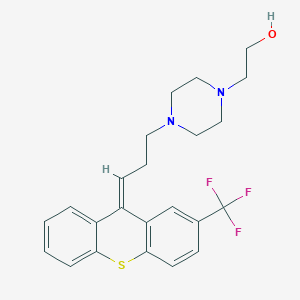Details of the Drug
General Information of Drug (ID: DM0DJ9O)
| Drug Name |
Flupentixol
|
||||||||||||||||||||||
|---|---|---|---|---|---|---|---|---|---|---|---|---|---|---|---|---|---|---|---|---|---|---|---|
| Synonyms |
2-[4-[(3Z)-3-[2-(Trifluoromethyl)thioxanthen-9-ylidene]propyl]piperazin-1-yl]ethanol; 4-(3-(2-(Trifluoromethyl)thioxanthen-9-ylidene)propyl)-1-piperazineethanol; 53772-82-0; ALPHA-FLUPENTHIXOL; EINECS 220-304-9; EINECS 258-756-4; Emergil; FA0UYH6QUO; FLUPENTHIXOL; Fluanxol; Flupenthixole; Flupentixol; Flupentixolum [INN-Latin]; Fluphenthixol; Fluxanxol; LC 44; N 7009; Siplaril; Siplarol; UNII-FA0UYH6QUO; cis-(Z)-Flupenthixol; cis-(Z)-Flupenthixol dihydrochloride; cis-Flupenthixol; cis-Flupentixol; flupentixolum
|
||||||||||||||||||||||
| Indication |
|
||||||||||||||||||||||
| Therapeutic Class |
Antipsychotic Neuroleptic drug
|
||||||||||||||||||||||
| Drug Type |
Small molecular drug
|
||||||||||||||||||||||
| Structure |
 |
||||||||||||||||||||||
| 3D MOL | 2D MOL | ||||||||||||||||||||||
| #Ro5 Violations (Lipinski): 0 | Molecular Weight (mw) | 434.521 | |||||||||||||||||||||
| Logarithm of the Partition Coefficient (xlogp) | 4.5 | ||||||||||||||||||||||
| Rotatable Bond Count (rotbonds) | 5 | ||||||||||||||||||||||
| Hydrogen Bond Donor Count (hbonddonor) | 1 | ||||||||||||||||||||||
| Hydrogen Bond Acceptor Count (hbondacc) | 7 | ||||||||||||||||||||||
| ADMET Property |
|
||||||||||||||||||||||
| Chemical Identifiers |
|
||||||||||||||||||||||
| Cross-matching ID | |||||||||||||||||||||||
| Combinatorial Drugs (CBD) | Click to Jump to the Detailed CBD Information of This Drug | ||||||||||||||||||||||
Molecular Interaction Atlas of This Drug
 Drug Transporter (DTP) |
|
||||||||||||||||||||||||||||||||||||||||||||||
|---|---|---|---|---|---|---|---|---|---|---|---|---|---|---|---|---|---|---|---|---|---|---|---|---|---|---|---|---|---|---|---|---|---|---|---|---|---|---|---|---|---|---|---|---|---|---|---|
 Drug Off-Target (DOT) |
|
||||||||||||||||||||||||||||||||||||||||||||||
| Molecular Interaction Atlas (MIA) | |||||||||||||||||||||||||||||||||||||||||||||||
References
